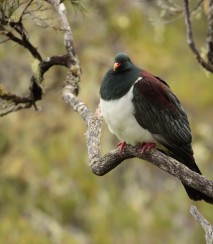
Species and environment
Forest birds
Our forests were once loud with birdsong. Many of these birds are similar to those on the mainland, but have evolved separately with their own unique characteristics. These birds also play an important role in helping forests regenerate. They pollinate plants and spread seeds.
The Chathams are home to 23% of the country's threatened and at-risk forest birds.
Here are some of our forest birds.
Black robin

Blackrobin on trunk
The karure (Moriori) or kakaruia (Māori), known more widely in English as the black robin, is one of the most iconic Chatham species. It's also critically threatened with under 350 adult birds.
They spend most of their time on the forest floor hunting for insects (weta are a favourite). This makes them very vulnerable to predation and this, combined with habitat loss and other factors, means there are few places they can successfully live.
Black robins used to be found in forests on all five main islands but started vanishing as predators like rats and cats appeared and their forest habitat began to disappear. By 1980 there were just five individual birds left. Their story of being brought back from the brink of extinction is one of Aotearoa's big conservation success stories.
Despite this success, only 345 adult birds were found after the 2023 breeding season. These birds are found on our predator-free nature reserve islands Rangatira/Hokorereoro and Mangere/Maung ‘Re, safe havens free of predators and where natural habitat has been regenerating over the last few generations. Work is underway to help their population grow through translocations and habitat restoration.
Parea
The parea, or Chatham Island pigeon, is one of the world's heaviest pigeons. It's 20% larger than the other pigeon species found in Aotearoa (the kereru), has an orange tip on the end of its beak, and is only found here.
Parea spend a lot of time foraging on the ground, but also depend on a diminished forest habitat. Today they're mainly found in the south-west of main Chatham. As predator control and plantings have been increasing over the island they've been seen further afield.
Their numbers have also increased from just 40 to around 500 individuals, thanks to conservation efforts including predator control in the south.
Parea on main Chatham (c.Jess MacKenzie)
Chatham Island snipe

Chatham Island snipe
The Chatham Island snipe is the smallest snipe in Aotearoa. They scuttle around the forest floor, their brown patterned feathers camouflaging them as they forage. They generally lay two eggs in the ground-level nests, breeding between July and April and producing chicks known as 'snippets'.
Snipe are found in abundance on the nature reserves and some other small islands. After cats were eradicated from Mangere/Maung 'Re, 23 snipe were reintroduced from Rangatira/Hokorereoro in 1970. They thrived here, going on to colonise nearby Little Mangere and Rabbit islands. This shows just how well it does without introduced predators.
How to help
Many of our forests birds spend time on the ground or low in the branches. Keeping pets in control and inside at night, and supporting predator control efforts, makes a huge difference.
Unsurprisingly, our forest birds also need forests! Planting native trees in gardens, shelter belts, and other farms can all contribute to future habitat or nature corridors that will help black robins and other birds return to our populated islands.
Be biosecurity conscious! If you're visiting or returning to the Chathams or transporting goods or livestock, be careful not to accidentally introduce pest animals, plants and seeds, or diseases. This poses risks to habitat, food species, and the birds themselves (not to mention other species on the islands).









